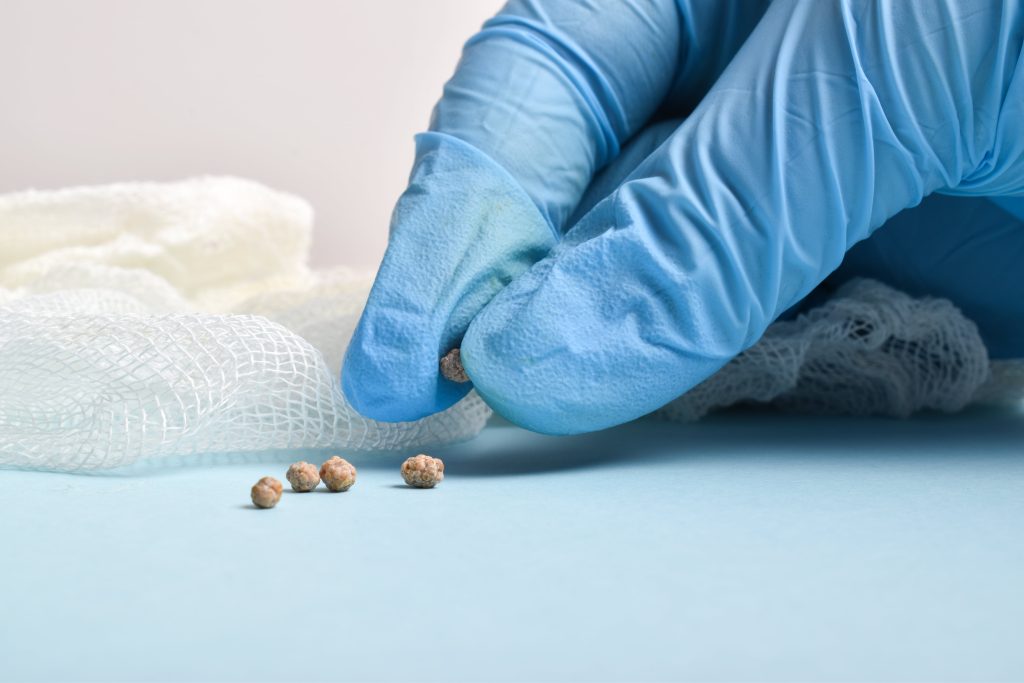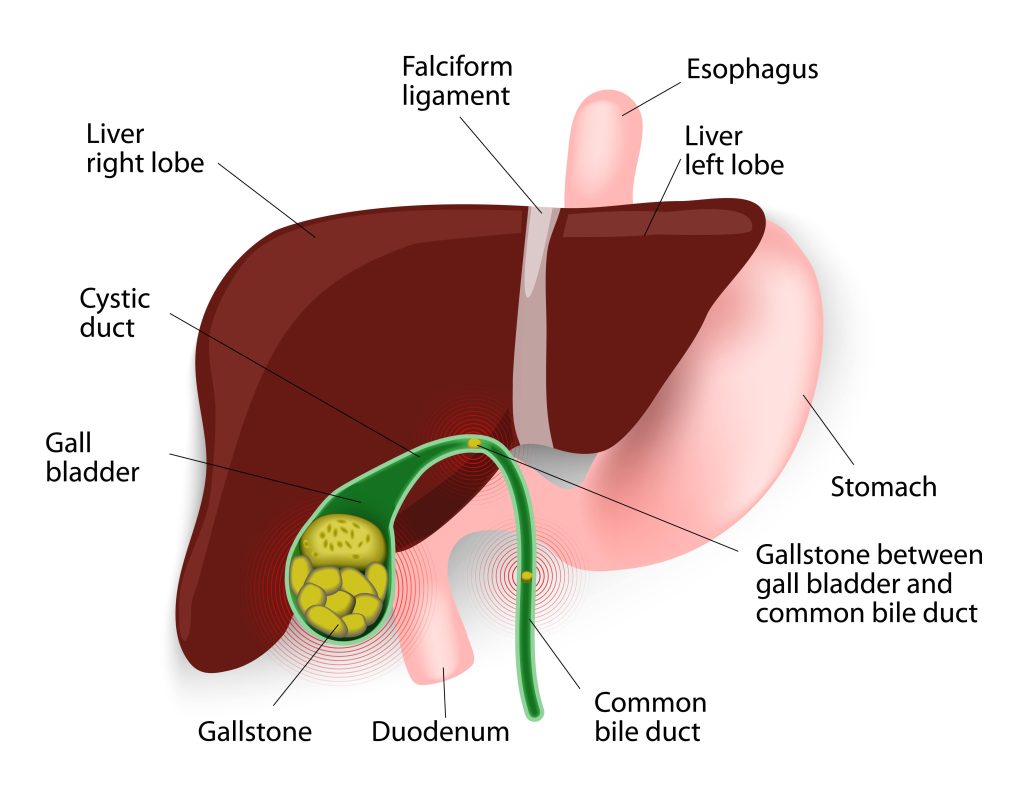
What are Bile Duct Stones?
Bile duct stones, also known as choledocholithiasis, is acondition in which there is at least one gallstone in the common bile duct (CBD). The common bile duct is a tube that carries bile from the liver and gallbladder into the small intestine. Bile duct stones are concentrated crystal-like particles formed by substances in the bile.
The majority of bile duct stones are made of cholesterol and are known as cholesterol stones, while some may be made of bilirubin (the main pigment in bile) and calcium, and these are called pigment stones. Bile duct stones can range in size from small grain-like stones to golf-ball-sized stones.
When these stones become stuck in the bile duct, medical intervention is necessary to prevent inflammation, infection or organ damage.

What is the Difference Between Bile Duct Stones and Gallbladder Stones?
There is no significant difference between the two, as bile duct stones are gallstones that have become stuck in the bile duct. However, as their names suggest, they differ in location. While these stones can develop in the gallbladder, some can be formed in the bile duct itself and are commonly found in individuals whose gallbladder has been removed.
Why are Bile Duct Stones a cause for concern?

Persistent blockage caused by bile duct stones can cause serious infection of the bile duct (acute cholangitis) or inflammation of the gallbladder (acute cholecystitis).
When inflamed, bacteria can spread to the bloodstream and also cause serious infections in other parts of the body (sepsis) and fever. Further complications could arise, such as the inflammation of the pancreas (pancreatitis) and liver abscess (accumulation of pus in the liver).
Moreover, an untreated blockage can lead to life-threatening conditions such as cholangitis or pancreatitis.
What Causes Bile Duct Stones?
Bile duct stones often result as a consequence of gallbladder stones (also sometimes known as liver stones) moving into the bile duct.
The Role of Bile
Bile serves as an emulsifier, breaking down large fat globules into smaller particles. When we consume food, the gallbladder releases bile to aid in digestion and absorption. Bile is produced by the liver from substances that are filtered from the blood and stored in the gallbladder. These substances include:
- Cholesterol
- Bile salts
- Bilirubin
- Lecithin
- Water
- Body salts
- Essential metals
Gallstones develop when the liver produces more substances than the bile can dissolve or if the gallbladder does not empty correctly. These substances then turn into a type of sediment, accumulating at the bottom of the gallbladder and gradually solidifies and grows. On other occasions, bile duct stones may develop in the bile duct itself and become lodged there.
Factors that increase the risk of developing bile duct stones include:
- High-cholesterol
- Obesity
- Rapid weight loss
- Prolonged fasting/parenteral nutrition
- Spinal cord injury
- Family history
- Crohn’s disease/ileal resection
- Hereditary blood cell disorders (e.g. Sickle Cell Anaemia)
- Being above the age of 40
- Female sex
- Pregnancy
- Diabetes mellitus
- Medications (e.g. fibrates, ceftriaxone, somatostatin analogues, hormone replacement therapy, oral contraceptive pills)
What Foods Increase the Risk of Suffering from Bile Duct Stones?
High-fat and processed foods may slow the gallbladder’s ability to help the body digest fat. As mentioned earlier, the liver secretes more cholesterol than the bile can dissolve. Hence, the excess cholesterol forms solid particles and accumulates in bile in the gallbladder. Conversely, a high-fibre and low-fat diet may help prevent bile duct stones.
What are the Symptoms of Bile Duct Stones?
- Pain in the upper abdomen, especially after eating
- Light-coloured stools
- Jaundice (yellowing of the skin or eyes)
- Fever
- Loss of appetite
- Nausea and vomiting
- Dark-coloured urine
However, some individuals with bile duct stones may be asymptomatic (no symptoms).
How are Bile Duct Stones Diagnosed?
Bile duct stones can go undetected if they do not cause any symptoms. If bile duct stones are suspected, it is usually because the stones are blocking the common bile duct, causing symptoms to manifest. To visualise the gallbladder and bile duct and identify the bile duct stones, your Gastroenterologist may order imaging tests such as an ultrasound, computerised tomography (CT) scan, and magnetic resonance imaging (MRI).
Other diagnostic tests include:
- Magnetic resonance cholangiopancreatography (MRCP) — A type of MRI that produces detailed images of the liver, gallbladder, bile ducts, pancreas and pancreatic duct.
- Endoscopic ultrasound — An endoscopic procedure with an ultrasound component that emits sound waves to produce detailed images of the linings of the gastrointestinal tract.
In addition to these tests, they may also order the following blood tests:
- Full blood count (FBC)
- Liver function tests (LFT)
- Bilirubin blood test
- Pancreatic function tests
How are Bile Duct Stones Treated?

Treatment of bile duct stones usually focuses on relieving the blockage, and this can be achieved by conducting certain endoscopic or operative procedures.
A complex endoscopic procedure known as Endoscopic Retrograde Cholangiopancreatography (ERCP) can be performed to remove these stones. This involves the insertion of an endoscope through the mouth and into the small intestine, and a smaller tube may be passed through the endoscope to reach the bile duct. A contrast dye is then injected backwards (retrograde) into the bile ducts and pancreatic duct and will highlight the structures on the X-ray. The stones are then removed using a basket- or balloon-type device.
The following procedures may also be used to treat bile duct stones in Singapore:
- Mechanical lithotripsy — Larger bile duct stones are broken up into smaller particles using a wire basket and removed through the endoscope.
- Intraductal electrohydraulic lithotripsy — A tiny probe inserted through the endoscope is used to produce shockwaves that break the bile duct stones into smaller pieces which are removed through the endoscope.
Gastroenterologists may prescribe some antibiotics for bile duct infections.
Patients are usually able to go home the day after the procedure following overnight observation.
Alpha Digestive & Liver Centre’s Medical Director and Consultant Gastroenterologist, Dr Benjamin Yip, reminds us: “Once you have your bile duct stones cleared by your Gastroenterologist, be sure to ask him/her to refer you to a surgeon to have your gallbladder removed as they often contain stones as well. If not, your bile duct stones may recur, causing you to have further problems down the road.”
Summary
Bile duct stones are often the result of gallbladder stones migrating into the bile duct and require medical intervention to prevent inflammation and life-threatening infections. If you experience any of the aforementioned symptoms, do reach out to our friendly team today and book an appointment to consult Alpha Digestive & Liver Centre’s well-experienced Consultant Gastroenterologist, Dr Benjamin Yip, for the proper diagnosis and treatment. All your gastrointestinal needs and concerns will be taken care of at our specialist clinic. We will be with you every step of your treatment journey.
References
- “Bile duct obstruction: Causes, symptoms, and treatment.” Medical News Today, 11 June 2018, https://www.medicalnewstoday.com/articles/322095. Accessed 19 May 2022.
- “Bile Duct Obstruction: Symptoms, Treatment, and Causes.” Healthline, https://www.healthline.com/health/bile-duct-obstruction. Accessed 19 May 2022.
- “Bile Duct Stones.” Michigan Medicine, https://www.uofmhealth.org/conditions-treatments/digestive-and-liver-health/bile-duct-stones. Accessed 19 May 2022.
- Gonzalez, Andrew. “Bile duct stones: Symptoms, causes, and treatment.” Medical News Today, 29 March 2021, https://www.medicalnewstoday.com/articles/bile-duct-stones. Accessed 19 May 2022.
- “MRCP (MR Cholangiopancreatography).” RadiologyInfo.org, https://www.radiologyinfo.org/en/info/mrcp. Accessed 19 May 2022.
- “Bile duct stones”. University of Michigan Health, https://www.uofmhealth.org/conditions-treatments/digestive-and-liver-health/bile-duct-stones. Accessed 1 March 2024.
- “Gallstones & Bile Duct Stones”. MUSC Health, https://muschealth.org/medical-services/ddc/patients/digestive-diseases/pancreas/gallstones-and-bile-duct-stones. Accessed 1 March 2024.

